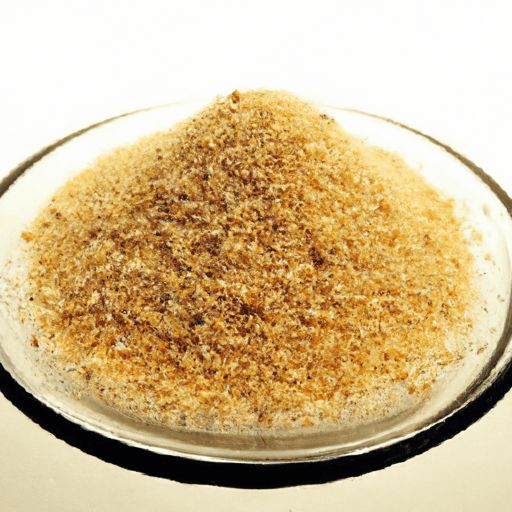The Magic of Bread Crumbs: Adding Texture and Flavor to Your Culinary Creations
When it comes to transforming ordinary dishes into culinary masterpieces, bread crumbs have a secret power that often goes unnoticed. These tiny, golden morsels bring a delightful crunch and a burst of flavor that adds a dimension to your favorite recipes. Whether you’re making meatballs, macaroni and cheese, or a crispy coating for fried chicken, bread crumbs are an essential ingredient that can elevate your cooking to new heights.
A Taste of Texture and Flavor
Bread crumbs offer a unique combination of crispiness, a toasty aroma, and a mild, nutty flavor. Their coarse texture adds a pleasant crunch that contrasts beautifully with softer ingredients, creating an exciting sensory experience for your taste buds. From the delicate crust on a perfectly executed slice of baked fish to the rich, golden coating of homemade chicken nuggets, bread crumbs enhance both the taste and visual appeal of a dish.
Versatility in the Kitchen
Bread crumbs are an incredibly versatile ingredient, finding their way into an array of dishes from various cuisines around the world. Their applications are limited only by your creativity and culinary exploration. Here are some common uses of bread crumbs in cooking:
1. Breading and Coating
One of the most popular uses of bread crumbs is for breading and coating proteins such as chicken, fish, or vegetables. Whether you prefer the traditional flour-egg-bread crumbs coating method or a gluten-free alternative, bread crumbs create a crispy outer layer that seals in moisture and adds a delightful texture. Try using flavored bread crumbs or adding herbs and spices to personalize your coating.
2. Topping and Binding
Bread crumbs make excellent toppings for casseroles, baked macaroni and cheese, and gratins. When toasted in the oven, they develop a beautiful golden color and a satisfying crunch. In meatloaf or meatballs, bread crumbs are used as a binding agent, absorbing moisture and keeping the mixture together during cooking.
3. Thickening Soups and Sauces
When simmered in a liquid, bread crumbs release their starches, creating a velvety texture that thickens soups and sauces. This technique is essential in recipes like Italian ribollita or classic French panade.
4. Filling and Stuffing
Whether you’re stuffing mushrooms, tomatoes, or bell peppers, bread crumbs make an excellent filling. They soak up the juices and flavors of the other ingredients, adding substance and texture to your culinary creation.
Nutrition Profile
While bread crumbs are not necessarily the epitome of nutritional excellence, they do offer some benefits. When made from whole grain bread, they contain fiber, minerals, vitamins, and complex carbohydrates. However, it’s essential to be mindful of the quantity used, as bread crumbs tend to be calorie-dense.
Fun Facts About Bread Crumbs
- Bread crumbs have been used for centuries in Mediterranean and Middle Eastern cuisines. Ancient Romans used them as fillers in recipes and, during the Middle Ages, they were used to thicken sauces.
- You can easily make your own bread crumbs by toasting stale bread and grinding it into fine particles.
- Panko, a type of Japanese bread crumbs, has gained popularity for its super-light and crispy texture. It is typically used in Japanese dishes such as tonkatsu or as a topping for gratins.
So, the next time you want to impress your friends and family with a deliciously crispy meal or give your favorite comfort foods an extra layer of flavor, don’t forget to harness the magic of bread crumbs. These humble golden treasures have the power to turn your simple dishes into culinary triumphs, ensuring a delightful and satisfying dining experience every time.
Origin: Bread crumbs are believed to have originated in ancient Egypt, where bread was used as a staple food. The process of making bread crumbs likely began as a way to utilize leftover or stale bread, allowing it to be preserved and used in various culinary preparations.
Common Uses: Bread crumbs are a versatile ingredient used in many different cuisines around the world. They are often used to coat and add texture to fried or baked foods, such as chicken cutlets, fish fillets, and vegetables. Bread crumbs can also be used as a binding agent in dishes like meatballs and crab cakes. In addition, they are frequently used as a topping for casseroles, gratins, and other baked dishes to create a golden and crispy crust.
Nutritional Benefits: Bread crumbs are a good source of carbohydrates, providing energy to the body. However, it should be noted that bread crumbs are typically low in other essential nutrients, such as protein, fiber, vitamins, and minerals. The nutritional content can vary based on the type of bread used to make the crumbs. It is always beneficial to incorporate other nutrient-rich ingredients when using bread crumbs to create a balanced meal.
Unique Properties and Historical Significance: Bread crumbs have several unique properties that make them useful in cooking. Due to their texture and absorbent nature, bread crumbs can help to bind ingredients together and retain moisture during cooking. They also provide a contrasting crunchy texture when used as a coating or topping.
Historically, bread crumbs have been an economical ingredient in many cuisines, as they allow for the use of leftover bread that would otherwise go to waste. In traditional Italian cuisine, sautéed bread crumbs are known as “pan grattato” and are used as a topping for pasta dishes, adding both texture and flavor.
Overall, bread crumbs serve as a practical and versatile ingredient in the culinary world, offering a multitude of uses and providing an extra crunch and texture to various dishes.




Use the share button below if you liked it.
It makes me smile, when I see it.